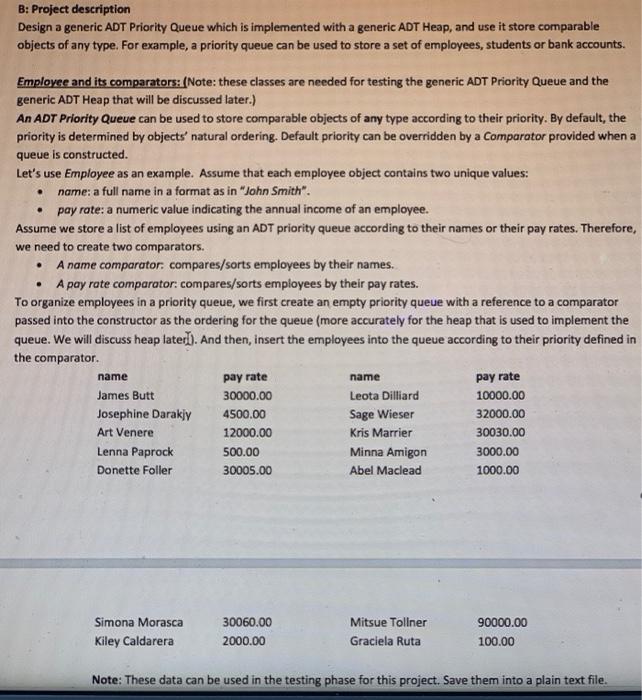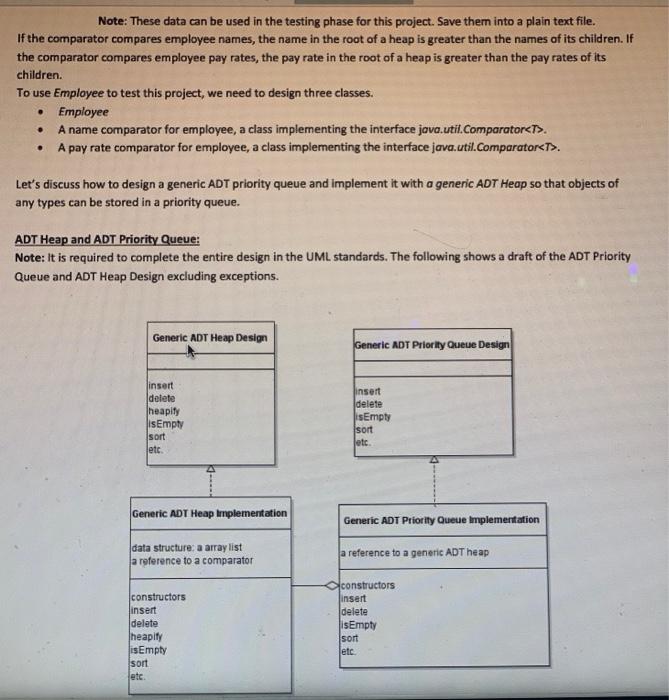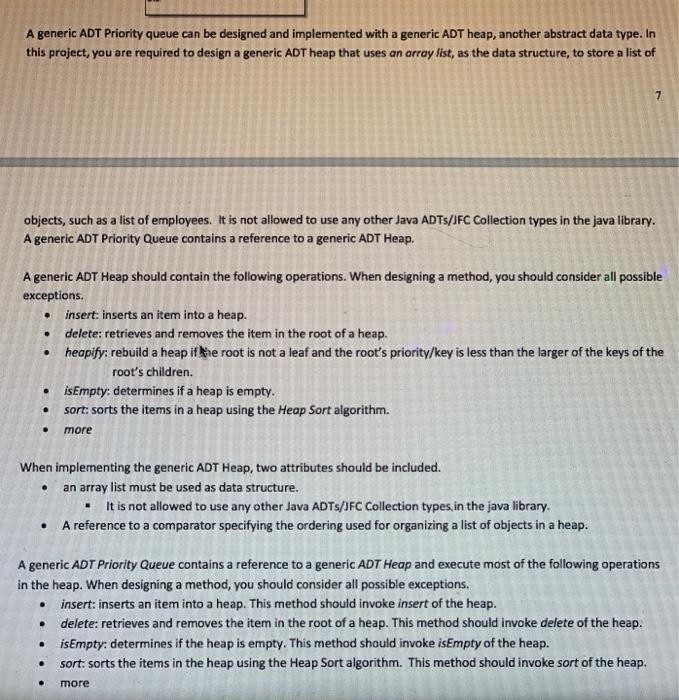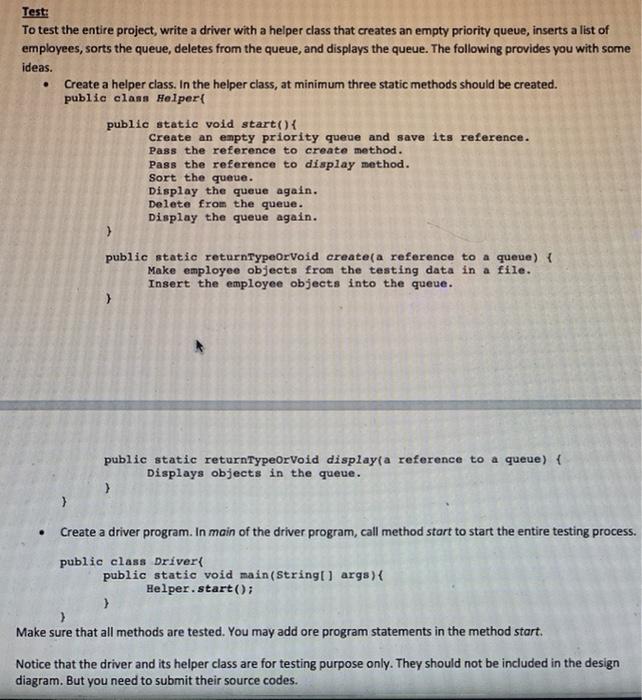please write those code in java.
Also draw the UML diagram.

B: Project description Design a generic ADT Priority Queue which is implemented with a generic ADT Heap, and use it store comparable objects of any type. For example, a priority queue can be used to store a set of employees, students or bank accounts. . . Employee and its comparators:/Note: these classes are needed for testing the generic ADT Priority Queue and the generic ADT Heap that will be discussed later.) An ADT Priority Queue can be used to store comparable objects of any type according to their priority. By default, the priority is determined by objects' natural ordering. Default priority can be overridden by a Comparator provided when a queue is constructed. Let's use Employee as an example. Assume that each employee object contains two unique values: name: a full name in a format as in "John Smith". pay rate: a numeric value indicating the annual income of an employee. Assume we store a list of employees using an ADT priority queue according to their names or their pay rates. Therefore, we need to create two comparators. A name comparator, compares/sorts employees by their names. A pay rate comparator.compares/sorts employees by their pay rates. To organize employees in a priority queue, we first create an empty priority queue with a reference to a comparator passed into the constructor as the ordering for the queue (more accurately for the heap that is used to implement the queue. We will discuss heap later]). And then, insert the employees into the queue according to their priority defined in the comparator. pay rate name pay rate James Butt 30000.00 Leota Dilliard 10000.00 Josephine Darakly 4500.00 Sage Wieser 32000.00 Art Venere 12000.00 Kris Marrier 30030.00 Lenna Paprock 500.00 Minna Amigon 3000.00 Donette Foller 30005.00 Abel Maclead . name 1000.00 Simona Morasca Kiley Caldarera 30060,00 2000.00 Mitsue Tollner Graciela Ruta 90000.00 100.00 Note: These data can be used in the testing phase for this project. Save them into a plain text file. Note: These data can be used in the testing phase for this project. Save them into a plain text file. If the comparator compares employee names, the name in the root of a heap is greater than the names of its children. If the comparator compares employee pay rates, the pay rate in the root of a heap is greater than the pay rates of its children. To use Employee to test this project, we need to design three classes. Employee A name comparator for employee, a class implementing the interface java.util. Comparator
. A pay rate comparator for employee, a class implementing the interface java.util.Comparator. Let's discuss how to design a generic ADT priority queue and implement it with a generic ADT Heap so that objects of any types can be stored in a priority queue. ADT Heap and ADT Priority Queue: Note: It is required to complete the entire design in the UML standards. The following shows a draft of the ADT Priority Queue and ADT Heap Design excluding exceptions. Generic ADT Heap Design Generic ADT Priority Queue Design linsert delete neapity IsEmpty sort etc. insert delete IsEmpty sort etc. Generic ADT Heap Implementation Generic ADT Priority Queue Implementation data structure: a array list a reference to a comparator a reference to a generic ADT heap constructors insert delete heapify isEmpty sort constructors insert delete isEmpty sort etc A generic ADT Priority queue can be designed and implemented with a generic ADT heap, another abstract data type. In this project, you are required to design a generic ADT heap that uses an array list, as the data structure, to store a list of objects, such as a list of employees. It is not allowed to use any other Java ADTS/JFC Collection types in the java library. A generic ADT Priority Queue contains a reference to a generic ADT Heap. . A generic ADT Heap should contain the following operations. When designing a method, you should consider all possible exceptions. insert: inserts an item into a heap. delete: retrieves and removes the item in the root of a heap. heapify: rebuild a heap if the root is not a leaf and the root's priority/key is less than the larger of the keys of the root's children. isEmpty: determines if a heap is empty. sort: sorts the items in a heap using the Heap Sort algorithm. more . . . When implementing the generic ADT Heap, two attributes should be included. an array list must be used as data structure. . It is not allowed to use any other Java ADTS/JFC Collection types in the java library. A reference to a comparator specifying the ordering used for organizing a list of objects in a heap. . . A generic ADT Priority Queue contains a reference to a generic ADT Heap and execute most of the following operations in the heap. When designing a method, you should consider all possible exceptions. insert: inserts an item into a heap. This method should invoke insert of the heap. delete: retrieves and removes the item in the root of a heap. This method should invoke delete of the heap. isEmpty: determines if the heap is empty. This method should invoke isEmpty of the heap. sort sorts the items in the heap using the Heap Sort algorithm. This method should invoke sort of the heap. . . . . more Test: To test the entire project, write a driver with a helper class that creates an empty priority queue, inserts a list of employees, sorts the queue, deletes from the queue, and displays the queue. The following provides you with some ideas. Create a helper class. In the helper class, at minimum three static methods should be created. public class Helper public static void start() { Create an empty priority queue and save its reference. Pass the reference to create method. Pass the reference to display method. Sort the queue. Display the queue again. Delete from the queue. Display the queue again. ) public static returnTypeorvoid create a reference to a queue) { Make employee objects from the testing data in a file. Insert the employee objects into the queue. > public static returnTypeOrvoid display(a reference to a queue) { Displays objects in the queue. > > Create a driver program. In main of the driver program, call method start to start the entire testing process. public class Drivert public static void main(String[] args) { Helper.start(); > Make sure that all methods are tested. You may add ore program statements in the method start. Notice that the driver and its helper class are for testing purpose only. They should not be included in the design diagram. But you need to submit their source codes. B: Project description Design a generic ADT Priority Queue which is implemented with a generic ADT Heap, and use it store comparable objects of any type. For example, a priority queue can be used to store a set of employees, students or bank accounts. . . Employee and its comparators:/Note: these classes are needed for testing the generic ADT Priority Queue and the generic ADT Heap that will be discussed later.) An ADT Priority Queue can be used to store comparable objects of any type according to their priority. By default, the priority is determined by objects' natural ordering. Default priority can be overridden by a Comparator provided when a queue is constructed. Let's use Employee as an example. Assume that each employee object contains two unique values: name: a full name in a format as in "John Smith". pay rate: a numeric value indicating the annual income of an employee. Assume we store a list of employees using an ADT priority queue according to their names or their pay rates. Therefore, we need to create two comparators. A name comparator, compares/sorts employees by their names. A pay rate comparator.compares/sorts employees by their pay rates. To organize employees in a priority queue, we first create an empty priority queue with a reference to a comparator passed into the constructor as the ordering for the queue (more accurately for the heap that is used to implement the queue. We will discuss heap later]). And then, insert the employees into the queue according to their priority defined in the comparator. pay rate name pay rate James Butt 30000.00 Leota Dilliard 10000.00 Josephine Darakly 4500.00 Sage Wieser 32000.00 Art Venere 12000.00 Kris Marrier 30030.00 Lenna Paprock 500.00 Minna Amigon 3000.00 Donette Foller 30005.00 Abel Maclead . name 1000.00 Simona Morasca Kiley Caldarera 30060,00 2000.00 Mitsue Tollner Graciela Ruta 90000.00 100.00 Note: These data can be used in the testing phase for this project. Save them into a plain text file. Note: These data can be used in the testing phase for this project. Save them into a plain text file. If the comparator compares employee names, the name in the root of a heap is greater than the names of its children. If the comparator compares employee pay rates, the pay rate in the root of a heap is greater than the pay rates of its children. To use Employee to test this project, we need to design three classes. Employee A name comparator for employee, a class implementing the interface java.util. Comparator. A pay rate comparator for employee, a class implementing the interface java.util.Comparator. Let's discuss how to design a generic ADT priority queue and implement it with a generic ADT Heap so that objects of any types can be stored in a priority queue. ADT Heap and ADT Priority Queue: Note: It is required to complete the entire design in the UML standards. The following shows a draft of the ADT Priority Queue and ADT Heap Design excluding exceptions. Generic ADT Heap Design Generic ADT Priority Queue Design linsert delete neapity IsEmpty sort etc. insert delete IsEmpty sort etc. Generic ADT Heap Implementation Generic ADT Priority Queue Implementation data structure: a array list a reference to a comparator a reference to a generic ADT heap constructors insert delete heapify isEmpty sort constructors insert delete isEmpty sort etc A generic ADT Priority queue can be designed and implemented with a generic ADT heap, another abstract data type. In this project, you are required to design a generic ADT heap that uses an array list, as the data structure, to store a list of objects, such as a list of employees. It is not allowed to use any other Java ADTS/JFC Collection types in the java library. A generic ADT Priority Queue contains a reference to a generic ADT Heap. . A generic ADT Heap should contain the following operations. When designing a method, you should consider all possible exceptions. insert: inserts an item into a heap. delete: retrieves and removes the item in the root of a heap. heapify: rebuild a heap if the root is not a leaf and the root's priority/key is less than the larger of the keys of the root's children. isEmpty: determines if a heap is empty. sort: sorts the items in a heap using the Heap Sort algorithm. more . . . When implementing the generic ADT Heap, two attributes should be included. an array list must be used as data structure. . It is not allowed to use any other Java ADTS/JFC Collection types in the java library. A reference to a comparator specifying the ordering used for organizing a list of objects in a heap. . . A generic ADT Priority Queue contains a reference to a generic ADT Heap and execute most of the following operations in the heap. When designing a method, you should consider all possible exceptions. insert: inserts an item into a heap. This method should invoke insert of the heap. delete: retrieves and removes the item in the root of a heap. This method should invoke delete of the heap. isEmpty: determines if the heap is empty. This method should invoke isEmpty of the heap. sort sorts the items in the heap using the Heap Sort algorithm. This method should invoke sort of the heap. . . . . more Test: To test the entire project, write a driver with a helper class that creates an empty priority queue, inserts a list of employees, sorts the queue, deletes from the queue, and displays the queue. The following provides you with some ideas. Create a helper class. In the helper class, at minimum three static methods should be created. public class Helper public static void start() { Create an empty priority queue and save its reference. Pass the reference to create method. Pass the reference to display method. Sort the queue. Display the queue again. Delete from the queue. Display the queue again. ) public static returnTypeorvoid create a reference to a queue) { Make employee objects from the testing data in a file. Insert the employee objects into the queue. > public static returnTypeOrvoid display(a reference to a queue) { Displays objects in the queue. > > Create a driver program. In main of the driver program, call method start to start the entire testing process. public class Drivert public static void main(String[] args) { Helper.start(); > Make sure that all methods are tested. You may add ore program statements in the method start. Notice that the driver and its helper class are for testing purpose only. They should not be included in the design diagram. But you need to submit their source codes











